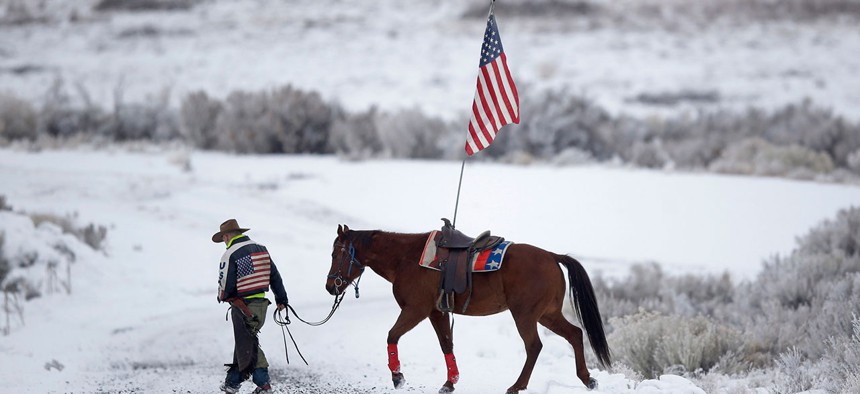Does the Government Track Anti-Public-Land Extremists?
Some Democrats allege that the Department of the Interior isn’t doing enough to protect public-land employees.
The United States government owns more than a fifth of the land in 12 states, all of which are in the West. Recently, Americans everywhere have been reminded of how controversial that fact remains.
In the past four years, armed militants have twice attempted to occupy federal facilities or stop federal employees from doing their job. In April 2014, Cliven Bundy and his supporters initiated an armed standoff with officers from the Bureau of Land Management, who were seizing Bundy’s cattle from federal land. Bundy’s cattle had previously illegally grazed on public property for 20 years.
Two years later, armed militants—including some of Bundy’s sons—occupied a small facility on Malheur National Wildlife Refuge in eastern Oregon to protest the federal government’s right to own any land at all.
Some supporters of public lands and former federal officials argue that these high-profile occupations are only the tip of a more serious crisis: a simmering and abusive siege on federal employees who work for the Bureau of Land Management, the Fish and Wildlife Service, the National Park Service, and other agencies that manage public lands.
They also allege that the federal government does not keep track of these types of extremist threats to federal employees.
On Friday, Democratic leadership on the House Natural Resources Committee will ask the Government Accountability Office to investigate whether any of the agencies that oversee public land systematically follow anti-federal threats against public employees. The Government Accountability Office is Congress’s watchdog over federal agencies and public finances.
“Unfortunately, while the events at Malheur may have been unusually public, they were not an isolated incident. Many of the Malheur plotters are associated with a broader anti-government movement that, for decades, has targeted federal facilities and employees throughout the Western United States,” says Raúl Grijalva, a Democratic congressman from Arizona and the ranking member on the House Natural Resources Committee.
In the letter, Grijalva requests that the GAO investigate whether any federal agency tracks threats from anti-government protesters or keep a security plan to address them. He also asks it to calculate the cost of “intentional damage done to federal property” by these groups.
David Hayes, the former second highest-ranking official at the Department of the Interior in both the Obama and Clinton administration, says that he does not believe any federal agency currently tracks threats or attacks from these groups “in a systematic way.”
“The Bundy situation and Malheur—those are obviously the extreme. And we have to hope they remain rare. But there’s quite a serious movement underfoot that needs to be confronted and dealt with,” Hayes told me.
“The violence is disturbing and the armed takeovers are disturbing. But what’s equally disturbing is what they’re fomenting—they are putting at risk the federal employees that are doing their job,” he said, referring to field workers and officers for the Bureau of Land Management, the Fish and Wildlife Service, and other agencies.
The committee’s Republican leadership declined to comment on the letter. The Department of the Interior did not respond to a request for comment before publication.
Last year, ranking Democrats on the Natural Resources Committee requested hearings on anti-government extremism, but Republican leadership declined to hold them. Democrats eventually held an unofficial “forum” with experts.
Rob Bishop, the Republican chairman of the committee and a Utah congressman, has previously disavowed both the Bundy standoff and the Malheur occupation while signaling that he understands the protesters’ anger.
“I want it to end without violence, but I also understand the frustration and feelings people have working with land agencies,” he told E&E News in January 2016. “They have been very heavy-handed.”
“This did not have to take place. If the Department of Interior was concerned about people instead of dogma this situation would not have occurred,” Bishop said later that month.
Hayes said that he hopes the letter to the GAO pushes lawmakers to take the threat more seriously. “What I hope comes out of this is confirmation that federal employees are, in fact, at risk,” he said. “There are hazards to their job, and they need to be supported more—and not singled out as though they were part of the problem.”




